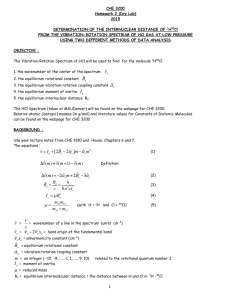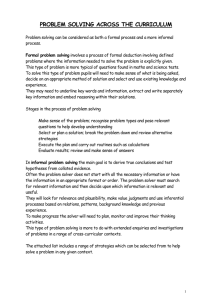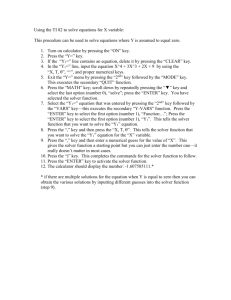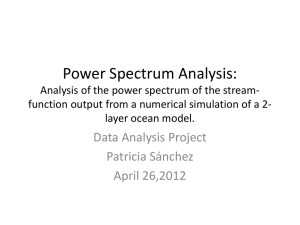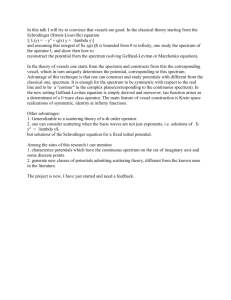equation coupling
advertisement
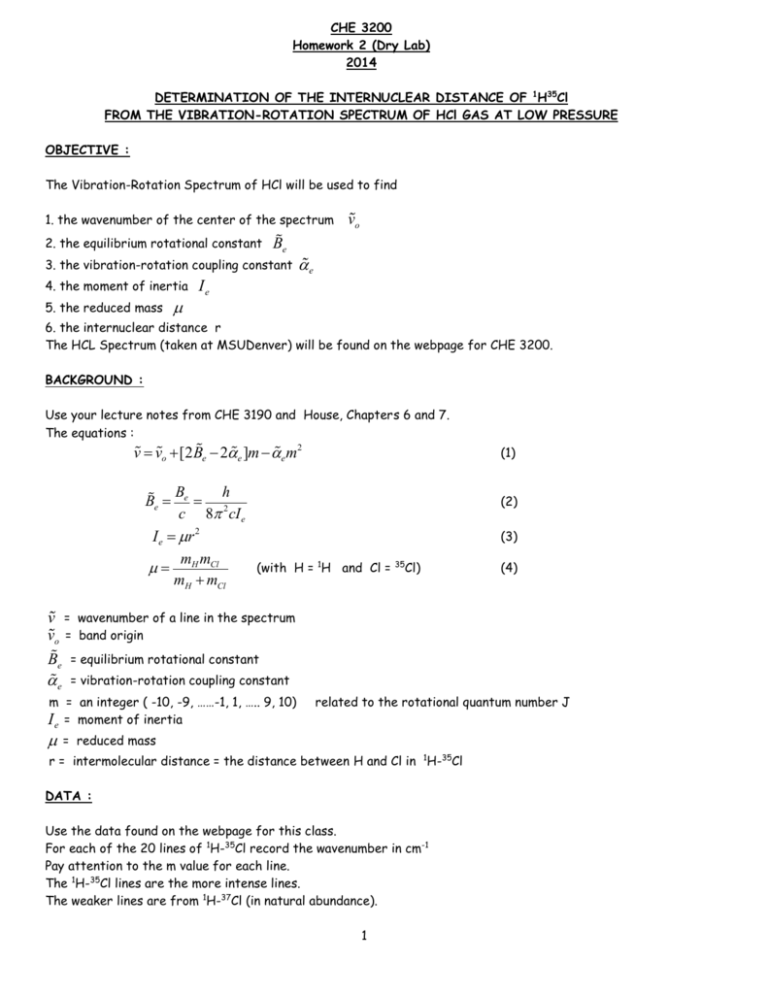
CHE 3200 Homework 2 (Dry Lab) 2014 DETERMINATION OF THE INTERNUCLEAR DISTANCE OF 1H35Cl FROM THE VIBRATION-ROTATION SPECTRUM OF HCl GAS AT LOW PRESSURE OBJECTIVE : The Vibration-Rotation Spectrum of HCl will be used to find 1. the wavenumber of the center of the spectrum 2. the equilibrium rotational constant Be 3. the vibration-rotation coupling constant 4. the moment of inertia 5. the reduced mass m vo ae Ie 6. the internuclear distance r The HCL Spectrum (taken at MSUDenver) will be found on the webpage for CHE 3200. BACKGROUND : Use your lecture notes from CHE 3190 and House, Chapters 6 and 7. The equations : v = vo +[2Be - 2ae ]m - ae m2 (1) Be h = 2 c 8p cI e I e = mr 2 m m (with H = 1H and Cl = 35Cl) m = H Cl mH + mCl Be = (2) (3) (4) v = wavenumber of a line in the spectrum vo = band origin Be = equilibrium rotational constant ae = vibration-rotation coupling constant m = an integer ( -10, -9, ……-1, 1, ….. 9, 10) I e = moment of inertia m related to the rotational quantum number J = reduced mass r = intermolecular distance = the distance between H and Cl in 1H-35Cl DATA : Use the data found on the webpage for this class. For each of the 20 lines of 1H-35Cl record the wavenumber in cm-1 Pay attention to the m value for each line. The 1H-35Cl lines are the more intense lines. The weaker lines are from 1H-37Cl (in natural abundance). 1 PROCEDURE : You will use the EXCEL Tool SOLVER (which uses the ‘Principle of Least Squares’ to fit an equation with up to 200 independent variables to experimental data). You will use one equation with three unknowns (equation 1). The data are the wavenumbers of 20 lines of the vibration-rotation spectrum of 1H35Cl gas. The three unknowns are : vo , Be and ae Open a new Excel spreadsheet and enter the first two columns using data from the HCl Rotation-Vibration Spectrum (m in column A, wavenumber v in column B) 1 A B CHE 3200 Homework 2 C D Exercise using SOLVER 2 3 m 4 -10 5 -9 6 -8 7 -7 8 -6 9 -5 10 -4 11 -3 12 -2 13 -1 14 1 15 2 16 3 17 4 18 5 19 6 20 7 21 8 22 9 23 10 di2 24 25 vo = 26 27 28 29 Be = ae = 30 31 32 33 2 In cell B26 enter a reasonable value for vo (the wavenumber of the center of the spectrum , the ‘band- origin’) In cell B28 enter a reasonable value for In cell B30 enter a value for In cell C4 calculate v Be (this is the separation of the lines in cm-1) a e ( a value between 0 and 5 works well) using equation (1) and the values for vo , Be , and a e you entered ($B$26, $B$28, and $B$30). These are the three variables which will be found by SOLVER. Copy down. In cell D4 calculate d2 =(B4-C4)2 . Copy down. In cell D24calculate SUM of all di2 Leave cell D24 selected and call up Solver (Tools Solver). The following window will appear: Enter : Set Objective : $D$24 (if it is not already entered) To : Min By changing variable cells : $B$26,$B$28,$B$30 Click on : Solve 3 SOLVER will return optimized values for Be a e in cells B26 , B28, B30 (it will take a littlr time for SOLVER to do the iterations). Use the optimized value of 1 Be (cell B28) to calculate the moment of inetrtia 35 Ie and the intermolecular distance r of H Cl using equations (2), (3), and (4) . Show the calculations. Pay attention to units. Report your values of : (a) (b) Be (c) ae (d) Ie m (e) Show calculation (f) r Try to find literature values for , Be , ae , Ie , r for 1H35Cl Include your Excel Spreadsheet using SOLVER. 4
